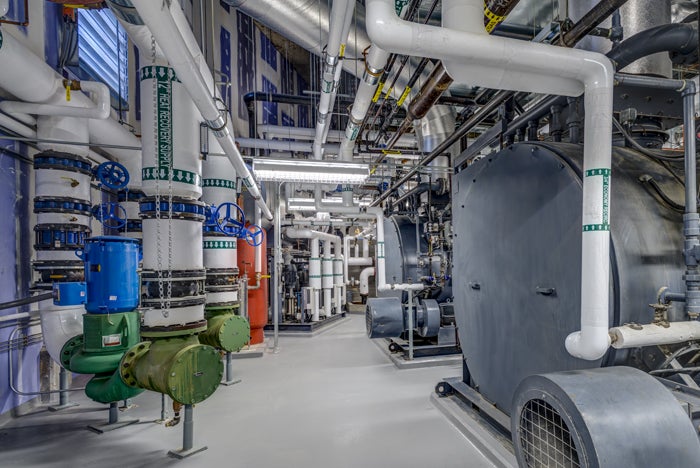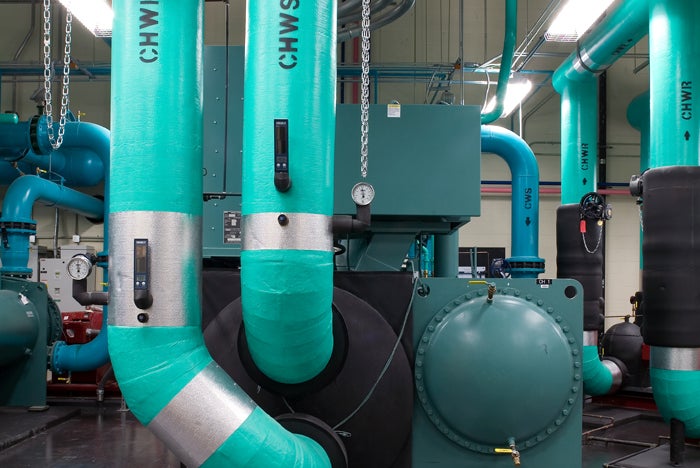Conducting alternate equipment-maintenance assessments

There are numerous approaches that can be effective in complying with the Centers for Medicare & Medicaid Services’ risk-assessment requirements.
Image courtesy of Smith Seckman Reid
The Centers for Medicare & Medicaid Services (CMS) changed the rules for both inventories and equipment inspection, testing and maintenance (ITM) requirements in late 2013. These changes require that, where law and regulations do not stipulate ITM, manufacturer recommendations must be followed unless the organization has a compliant alternate equipment-maintenance (AEM) program.
The CMS requirements for an AEM inclusion risk assessment as presented in the original December 2013 CMS Survey & Certification (S&C) Letter S&C:14-07-Hospital (titled “Hospital Equipment Maintenance Requirements”) go far beyond any previous utility equipment risk-assessment requirements.
CMS also instructs state agency surveyors who will be surveying on behalf of CMS to assess compliance with those requirements whenever hospitals deviate from manufacturer recommendations. It also appears that the accrediting organizations (AOs) are likely to be more direct in their probing of these processes in 2018 and beyond.
There are numerous approaches that can be effective in complying with the CMS AEM inclusion risk-assessment requirements.
The following comprehensive approach is intended to comply with all CMS requirements while providing options for facility-specific differences and needs. Consideration of the robust approaches indicated is recommended, but may not be necessary for specific hospitals.
AEM requirements
The CMS-issued S&C Letter S&C:14-07-Hospital includes 11 pages of surveyor guidance in “Appendix A interpretive guidelines §482.41(c)(2)” that list the following requirements for AEM inclusion-risk assessments:
- Typical health and safety risks
- “ … adequate provisions to ensure the availability and reliability of equipment … ”
- Identifying critical equipment (The Joint Commission’s high-risk phraseology is the same.)
- Different types of equipment presenting different combinations of severity of potential harm and likelihood of failure
- How the equipment is used (e.g., life support, infection control or life safety) and the likely consequences of equipment failure or malfunction
- Health care setting(s) impacted by equipment failure or malfunction including the entire hospital and other types of areas, patient acuity and how widespread
- How serious and widespread the harm is likely to be
- Manufacturer’s maintenance recommendations and rationale
- Whether maintenance requirements of the equipment are simple or complex
- Timely availability of alternate devices or backup systems
- Service history is also considered, including the number, frequency and nature of previous failures and service requests, as well as incident histories of identical and very similar equipment.
CMS also stated: “Generally multiple factors must be considered, since different types of equipment present different combinations of severity of potential harm and likelihood of failure. The hospital is expected to be able to demonstrate to a surveyor the factors it considered in its risk assessment for equipment placed in its AEM program.”
In both cases, the AEM inclusion risk-
assessment factors go beyond the more commonly used factors that hospitals have used either in previous utility system or medical equipment-risk assessments.
Based on all of this, a new risk-assessment framework is required to support health care facility utility equipment AEM-inclusion decisions.
Sample AEM metrics
Health facility professionals can develop risk metrics categories from studying the guidance and applying it to their specific operations. All example risk-metric values discussed are for explanatory purposes only. A reader’s values are likely to differ based on facility conditions.
Resources
• Alternates or backups. CMS requires organizations to consider whether alternates or backups are available and, if so, how quickly and how easily. The Joint Commission does not stipulate either the quickness or ease of providing the backup, but those attributes could be inferred by the term “availability of backup equipment.” Automatically connected equipment is clearly faster and easier than manually energized equipment, which requires operator action.
Another consideration that reduces risk is whether the equipment has N capacity (the amount needed to serve the peak load), N+1 capacity (twice as much as needed) or N+2 (three times as much as needed) capacity. Utility equipment-risk assessments also may take into account whether there are multiple pathways to deliver the capacity to the loads, which also could be considered as N or N+1.
And, finally, off-site equipment that can be connected to a permanently installed on-site connection point, such as a generation connection box for a rental portable generator set, is better than nothing at all, because the connection is likely to be speedier; however, a weather disaster might impede delivery of that backup equipment.
A basic risk-assessment approach for this issue could be a simple set of risk factors such as +6 for no backups, +3 for manual backup features that require human action, and a risk factor of 0 (i.e., no capacity risk) for full, automatic-capacity backup of the equipment being considered.
A more robust approach could have the same +6 risk factor for no backups, +3 risk factor when there are provisions for connecting off-site equipment that still must be acquired and transported to the facility, +1 for installed backup equipment that requires human intervention, and the same 0 risk factor for automatic N+1-
capacity backup, and then even perhaps negative factors (meaning even less risk) when the distribution system has backup distribution pathways.
• Manufacturers’ recommendations. Historically, these have been considered either by simple descriptions or by calendar-based preventive maintenance (PM) intervals. Because the manufacturers’ recommendations are indeed the maintenance requirements unless the AEM inclusion-risk assessment indicates that AEM is an appropriate equipment-management protocol (and AEM is chosen as that equipment-management process), the metrics therefore would be the same for both categories. A simple approach could be +8 for extensive requirements, +4 for average requirements and +1 for minimal requirements. Another approach when manufacturers recommend calendar-based, PM intervals is to have graduated risk factors reflecting more frequent recommendations.
• Probability of equipment failure. Hospitals historically have categorized failure probability as minimal, some or extensive. Examples of risk-factor metrics for probability of equipment failure could be extensive problems (+8), some problems (+4) and minimal problems (+1). Or, for a more robust approach, an option could be probable (+6), occasional (+4), remote (+2), improbable (+1) and, finally, very rare (0).
Moreover, with CMS requesting consideration of the specific types of equipment being risk-assessed vs. similar types to the type being risk-assessed, this appears a good place to differentiate between those two issues by considering “similar equipment” as opposed to “this equipment.” For example, “some problems on similar equipment” could increase the risk factor by a few points whereas “some problems on this equipment” could increase the risk by even more points.
• Frequency and nature of incident and service history. The next two AEM inclusion risk-assessment categories are frequency of incident history and service history, and nature of incident history and service history. Some organizations collect these data as one type of information; others collect the two categories separately. The frequency category lends itself to simple descriptors — either as minimal/some/extensive or as a summary of the frequency of corrective work orders related to equipment history.
The risk factor types for these questions may be very similar to the risk factors used for the probability of equipment failure examples stated previously. Good incident records also could allow you to base these risk factors on documented failure histories.
The nature of incident history and service history could be related to use errors, which are not to be considered as an AEM management issue, according to CMS. And training issues that result in use errors should be treated similarly. Again, the risk-factor types for these questions may be very similar to the risk factors used for the probability of equipment failure examples. The organization could decide to use risk factors such as major issues and minor issues.
• Severity and impact of failure. There are several ways to look at issues related to severity of failure and impact of failure. Consideration of each approach is recommended, because they all have validity when considering both severity and impact of equipment failure.
CMS specifically addressed critical equipment within the S&C letter, so this risk factor should be included. As an example, critical equipment could have a risk factor of +6 and noncritical equipment could have a risk factor of 0.
The equipment purpose is another mandatory risk factor. Equipment purpose lends itself to risk factors considering the following categories: life support (+9), life safety (+8), infection control (+7), general patient care (+4) and nonpatient care (0), for example.
The NFPA 99-2012 risk category was not mentioned in the CMS S&C letter, probably because at that time, CMS had not yet adopted NFPA 99-2012. Since this risk categorization is likely to be a pervasive part of future utility-system management, it is also included here for consideration, and it can allow for further differentiation between various degrees of noncriticality.
As a caution, when one looks at the definitions of critical equipment and NFPA 99-2012 Category 1 equipment, although they are similar, those two definitions are not the same. The difference is a matter of degree between the riskier NFPA 99 Category 1 “is likely to … ” and slightly less risky critical “could cause … .”
• Setting served by the equipment under consideration. This appears to be more related to patient dependence on the utility equipment as well as patient acuity than on other issues. A simple approach could consider nonpatient care (0), general patient care (+2), acute care (+4 or higher) and hospitalwide (+9). Hospitalwide is the riskiest category because it includes all other areas simultaneously. A more robust approach could split acute care into operating rooms (+7), intensive care units, critical care units, emergency departments (+5), and central sterile/high-level disinfection (+4).
• Equipment function. A simple approach to equipment function could consider acute care (+4), general patient care (+2) and nonpatient care (0). A more robust approach considering equipment function could use risk factors such as life support (+9), life safety (+8), infection control (+6), environment (+4), communications/electronic health records (+4) and convenience (0). Many hospital engineers will be familiar with the equipment function options under the robust approach, because many historical utility system criticality-risk assessments used a similar list.
• Risk to patients and/or staff. The patient/staff risk category probably could be covered by the same sort of analysis as the severity and impact of failure analysis.
The template for an AEM inclusion risk-assessment methodology in the supplemental materials [see the table on Page 35] illustrates a convenient way to identify for a regulatory surveyor how a metric addresses the authority having jurisdiction’s AEM inclusion risk-assessment requirements.
The AEM inclusion-risk assessment is not just a number-crunching exercise. The last step of the risk-assessment process is to compare the manufacturers’ ITM recommendations with the intended AEM ITM protocols to ascertain the impact and acceptability of deviating from the manufacturers’ recommendations.
Future surveys
No two hospitals are likely to make the same decisions, in large part because few health care facilities are identical in both infrastructure and maintenance operations.
Some hospitals have decided to change their existing protocols to adopt some manufacturers’ recommendations because they made sense to those organizations upon review.
Other hospitals did not see the need to change their existing ITM protocols to the manufacturers’ recommendations because of their successful equipment operational history and cost considerations.
There appears to be a high likelihood that future surveys will focus more on AEM inclusion-risk assessments than they have in the past.
David L. Stymiest, PE, CHFM, CHSP, FASHE, is a senior consultant at Smith Seckman Reid, Nashville, Tenn., specializing in facilities engineering and regulatory compliance. He can be reached at DStymiest@SSR-inc.com.





